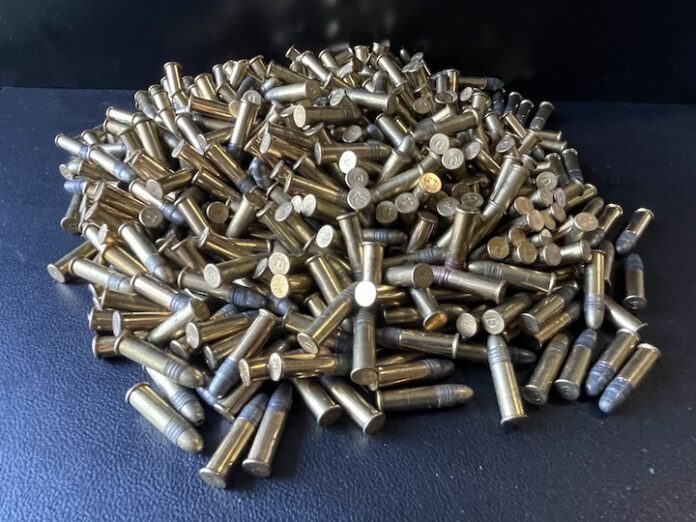
BY TIM E. HOVEY
If you’ve been involved in shooting sports over the last decade you’ve probably noticed a steady increase in the price of ammo. Whether it’s a continuation of the ammo shortage that began around 2015, a parting ripple from COVID or basic cartridge component shortages, your $1.25 box of 50 .22 ammo is likely gone forever.
Over the last few years, I’ve made sure that I have plenty of ammunition in the calibers I regularly shoot. Despite the constant suggestion from several friends to get into reloading, I just know that I never will. Along those lines, I’ve become cost-conscious when I do purchase off-the-shelf shells. Just like most of us, I want the best deal I can get.
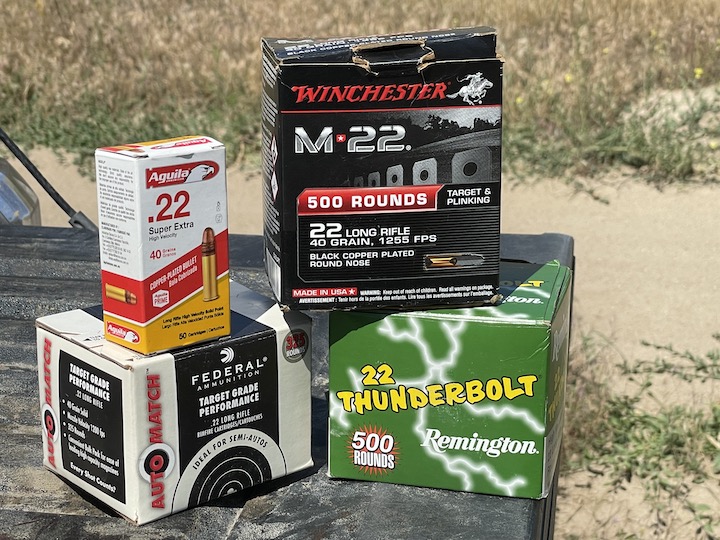
Whenever I’m at a sporting goods store, I always take a swing by the ammo section to see what’s available and how things are priced. If the deal looks reasonable, I’ll grab a few boxes of whatever to add to my supply.
Several years ago, I saw where one store had three different brands of .22 ammo all priced differently. I examined each box and noticed they had the exact bullet weight and muzzle velocity. Two of the manufacturers were well known companies in the shooting world, the third I had not heard a lot about. I passed by the cheaper newcomer and picked up several boxes of the more expensive name brands.
Leaving the store, I started wondering what the real difference was between the rounds, other than the price. At that time, I figured that there was little difference between a .22 round no matter who produced it, especially with identical round specifics. Even with that mindset, I chose to purchase the more expensive bullets. That’s when I started thinking about doing my own testing.
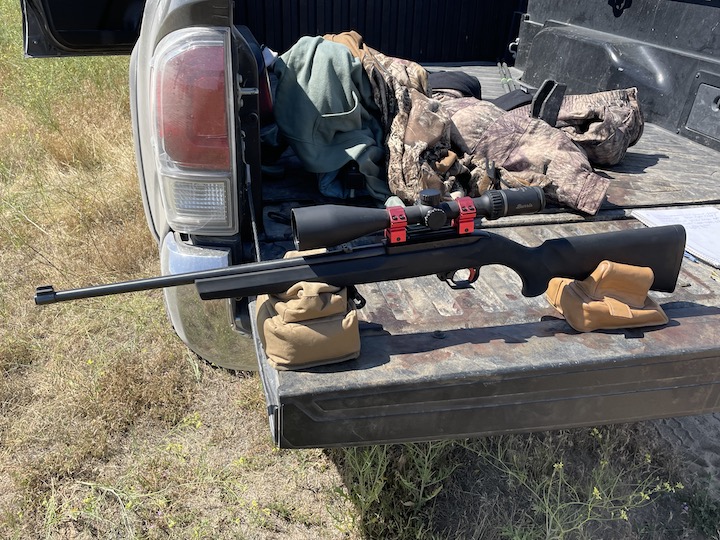
Recently, I did a quick inventory of my stash of .22 ammo (probably close to 20,000 rounds). Over the years, I’ve accumulated just about every brand available, again thinking that one bullet was just as good as the other. I found four different brands with identical bullet weight and near identical muzzle velocity. I set those aside and started designing my experiment.
I wasn’t going to set up a chronograph and look at the differing average muzzle velocities between brands. I also wasn’t interested in the bullet performance out at extreme distances. The .22 round is a round nosed bullet that tends to stray considerably out in the 100-yard range. Environmental conditions, especially wind, can further alter the bullet path of this slower, chubbier bullet.
I wanted to look at which bullet grouped the best out of the same rifle, and what the price point for each brand was. Essentially, I wanted to look at why 99.9% of hunters and shooters buy .22 ammo off the shelf; cheap is good, but we also want performance.
For the test firing, I chose my tried and true, Ruger 10/22. I recently upgraded the rifle with a new crisper trigger and bolt group and topped it with a Burris Fullfield E1 6.5 – 20 X 50 scope. It’s a light, accurate and very reliable firearm.
After considering different distances, I settled on 40-yards. It’s a good plinking and small game hunting distance. To avoid just wasting ammo, I decided to load up five rounds of each brand and shoot off a steady rest and see what the results were.
I loaded up all my target shooting gear and headed towards the desert. At the spot, I set up my target at a laser ranged 40-yards. I set up shooting bags on the tailgate of my truck and got things adjusted so that I was dead still on target. Add in the new trigger and I could easily keep the crosshairs in the orange, inch-wide target bullseye when I squeezed the trigger. To even the playing field further, I shot five rounds out of the cold barrel before I started testing.
Each bullet being test-fired had a 40-grain projectile and near identical muzzle velocity (three brands had a MV of 1,255 fps and the fourth had a MV of 1,200 fps). Given the test distance of 40-yards, I didn’t believe that the round with the lower muzzle velocity of 1,200 fps would perform any differently.
Before I fired the first shot downrange, I still believed that the simplicity of the .22 round made them pretty much identical. Honestly, I expected similar groupings and the same reliability. That’s not what I got.
The results were so dramatically different, that I will no longer purchase certain brands over another when I find them. The groupings range from 0.875 inches to 2.9375 inches. One brand performed so poorly in the reliability portion (duds), that I had to load 15 rounds just to get five that fired.
I randomly chose the brand order in which I was going to fire the rounds. Up first was the .22 Thunderbolt high-velocity ammunition by Remington. The green Remington boxes have been a staple for target shooters and small game hunters for decades.
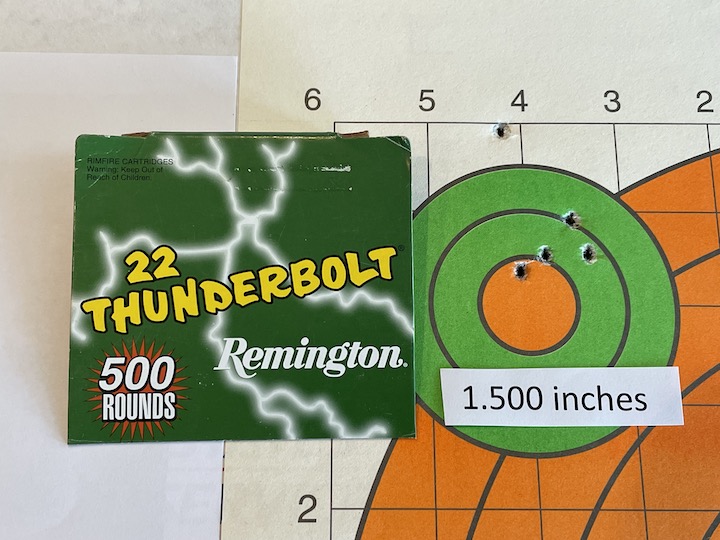
Five Remington rounds were loaded into the magazine, and all five fired flawlessly. Looking through the scope, I saw a relatively tight four-round group, with one flyer. The group measured 1.500 inches and I considered the grouping a pretty good representation of the round at that distance. The price per round of the Remington 22 Thunderbolt is 6.0 cents per round.
Next up was the M.22 long rifle round from Winchester. This 500-round box was the only box of M.22 I had, and I remember buying it at a far higher price than the others. The high price of the ammo is the reason I only had one box.
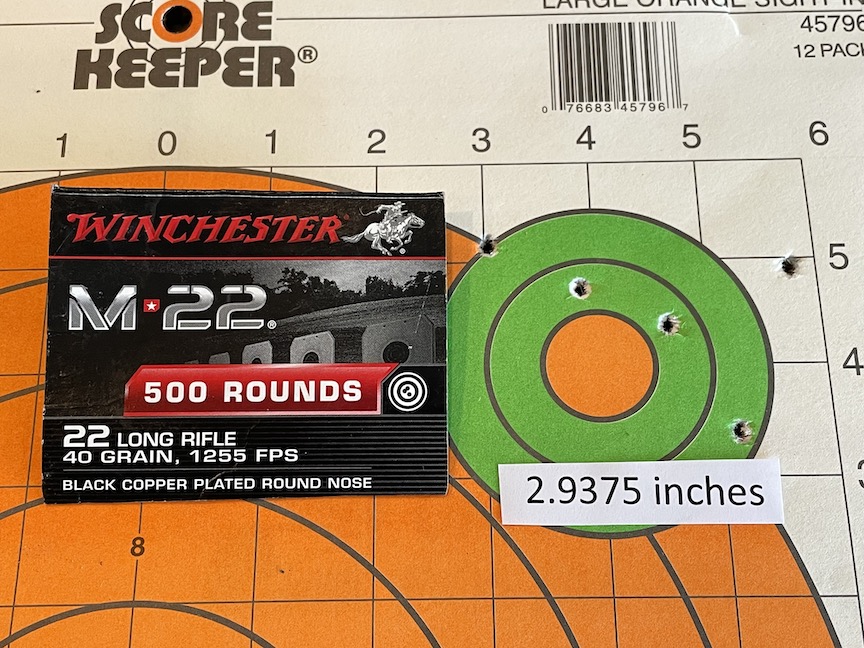
I loaded five Winchester rounds into the magazine and replaced it into the rifle. I pulled the bolt back, settled in and squeezed the trigger…click. I ejected the round and tried again. Same result. In fact, the first three rounds of the M.22 ammo were duds and did not fire. I had to load fifteen rounds into the magazine to eventually get the five I needed for the test.
For a 40-yard distance, the Winchester grouping was terrible, measuring in at nearly three inches (2.9375 inches). Examining the group, the rounds were all over the place, starting at one side of the outer rings of the target and moving across and off the bullseye. None of the rounds were close to the other, and they appeared to be migrating. This told me there was no round-to-round consistency. The price per round of the M.22 was 7.5 cents per round.
The next ammo up for testing was a box of 40 grain Aguila Super Extra .22. Manufacturing ammunition for Latin America since 1961, the shortages here in the states have opened up another market for this smaller company. In all honesty, I did not purchase the 50-round box Aguila ammunition, it was given to me by a friend who doesn’t shoot.
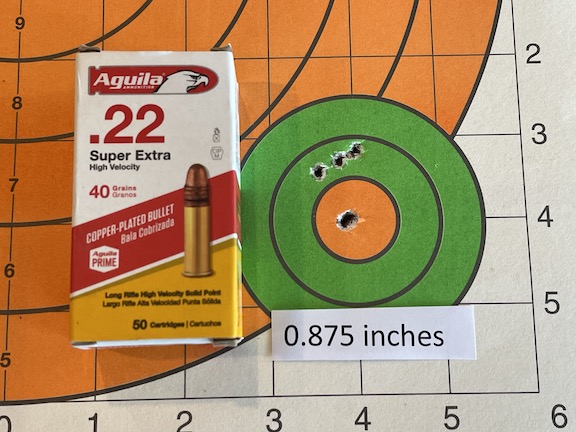
I loaded up five rounds of the Aguila Super Extra ammo and got started. The first round hit dead center in the bullseye. It took me a while to realize that the second round had gone through the same hole as the first. The next three were in a tight group just above the bullseye. All five rounds fired flawlessly, and the group measurement was 0.875 inches, the tightest group of the testing. The price per round of the Aguila .22 ammunition was 6.0 cents per round.
It should be mentioned that there have been several times over the last few years where I passed up purchasing Aguila .22 ammo because I didn’t know much about them and was honestly skeptical. That is no longer the case.
Last up for the ammo test was the target-grade ammo by Federal Ammunition. This ammo has been a staple for small-game hunters looking for target-level performance.
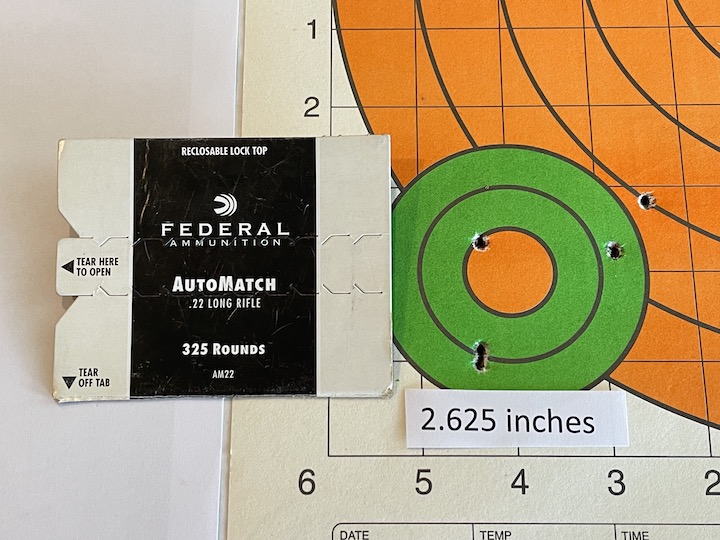
All five shots from Federal fired flawlessly. However, the grouping seemed to be scattered, measuring in at 2.625 inches, the second largest group measurement of the test. The price per round of the Federal ammo was 5.8 cents a round.
CONCLUSION
I do understand that rimfire ammunition like the .22 is produced in mass and very quickly. However, the quality of this process is closely monitored to produce the best and most consistent product possible. Some brands obviously do this better than others.
I was surprised at the grouping differences produced by this test. The tightest group produced by the Aguila ammunition was over two inches smaller than the largest group produced by the M.22 Winchester ammo. At the test distance of 40 yards, that’s a significant difference. As you extend that distance out, maybe during a hunt, this difference in impact consistency between these two brands would most definitely result in a hit for Aguila and clean miss for the M.22 Winchester ammo.
As if to add accuracy insult to injury, the M.22 Winchester ammunition was the more expensive ammo of the test, at 7.5 cents a round. When pennies are extended out to thousands of rounds, you would expect a higher degree of accuracy and product consistency. The M.22 ammo was the only ammunition tested that had several misfires or duds during the test firing of only five rounds. Considering the loose groupings, the higher price and the inconsistent product quality, I will not be purchasing M.22 Winchester ammunition again.
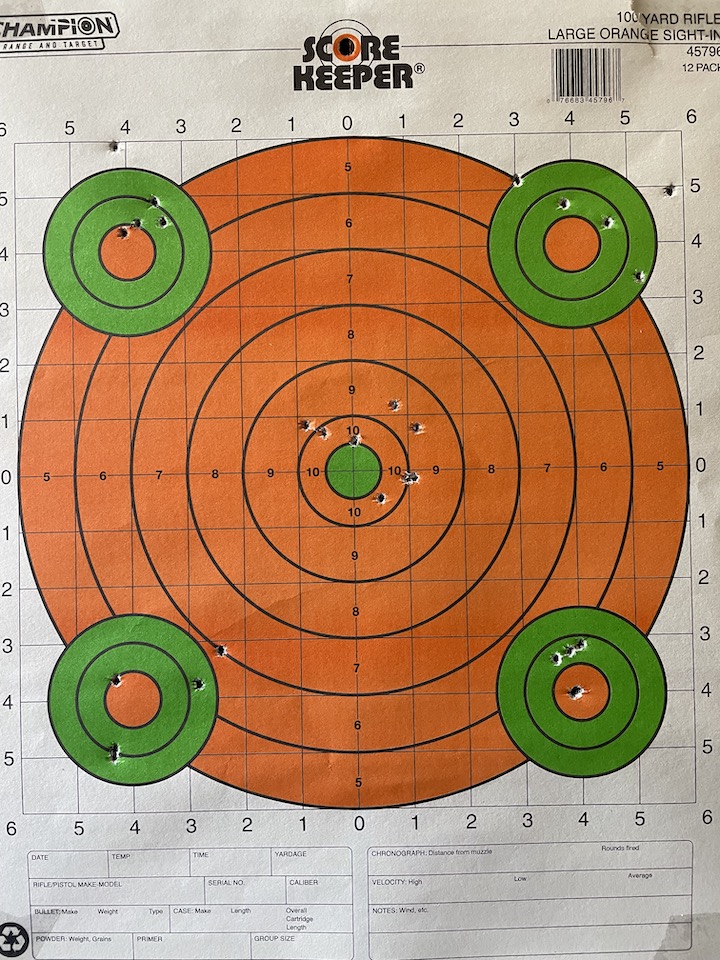
The Remington and Federal ammo performed adequately and are both priced at or lower than the lowest price point. Remington impressed me with a consistent, relatively tight grouping, with only one shot being a flyer; a shot that could easily be attributed to shooter error.
The overall best performer during this test shoot was hands down the Aguila 22 Super Extra ammunition. This fairly recent addition to the US ammunition market is priced right and performed well during this test. If this product is available on the shelves and remains consistently priced, I’ll pick it up.
Ranking my choices, the top three are easy. Aguila is first, the Thunderbolt .22 by Remington is a close second, putting the Federal target grade ammo a distant third to the top two. The M.22 Winchester ammo performed poorly and ranks a distant last.
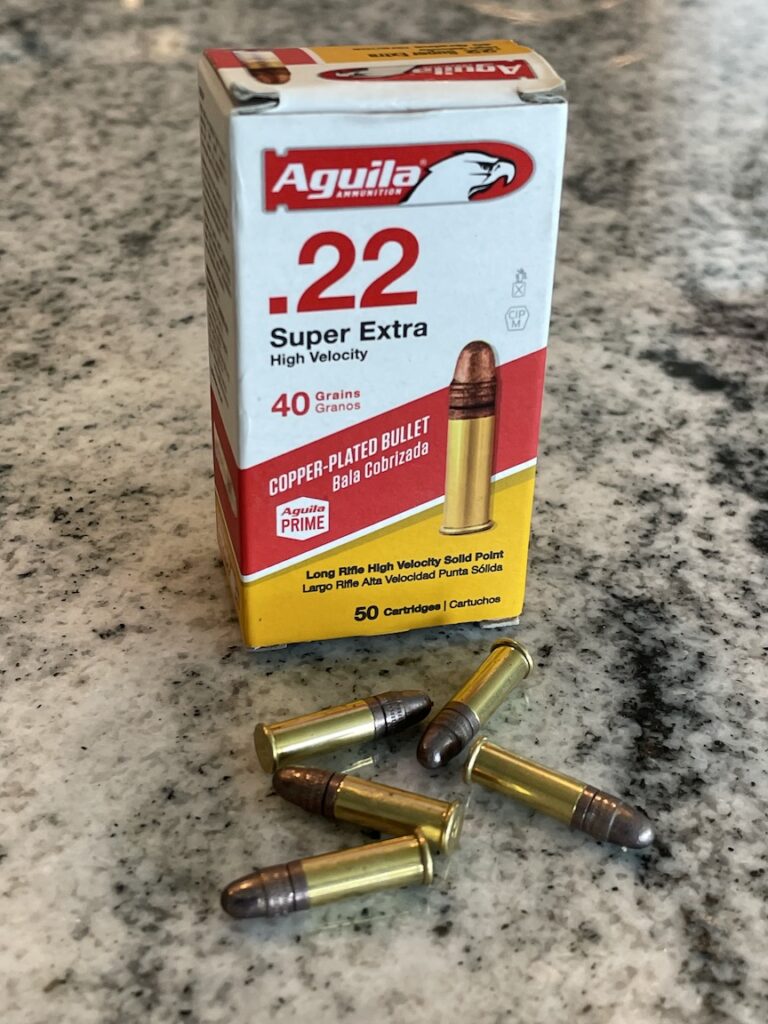
This test answered a question for me. I once thought that all .22s perform similarly. The results of the test firing proved me wrong. I also discovered that the price point of some ammo may be deceiving in their quality. The next time you see a box of Aguila ammo on the shelf, don’t second guess the price. In my opinion, it is as good or better than some of the name brands.


